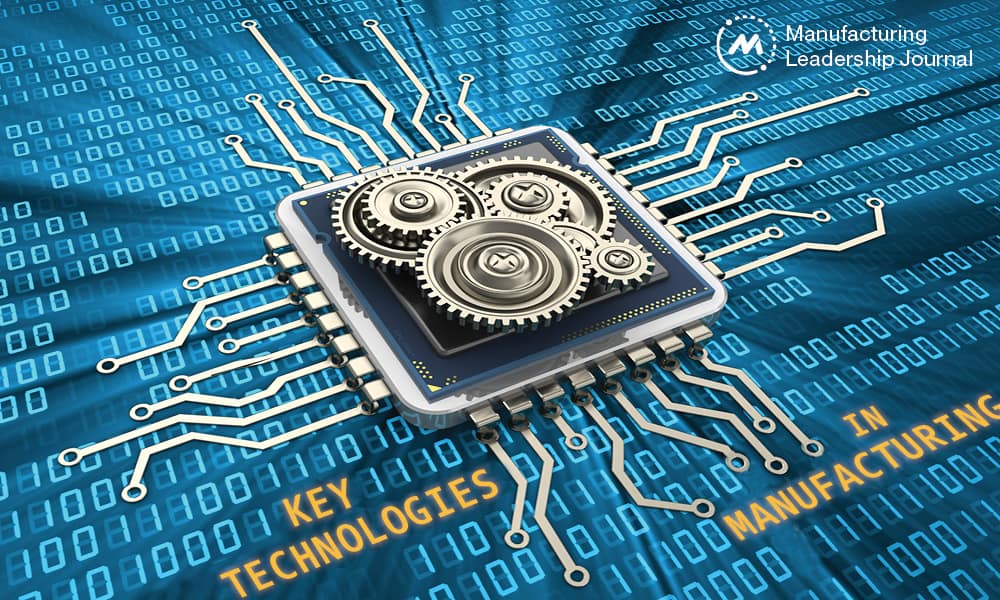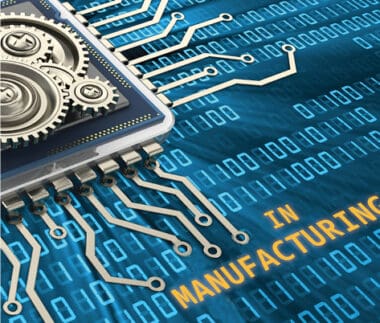Key Technologies In Manufacturing

Successful manufacturers find ways to ensure that digital change leads to evolution, not disruption.

Technology advances give businesses, governments and public sector institutions more possibilities to enhance their productivity, invent and reinvent offerings, and contribute to humanity’s well-being.
Just as manufacturing executives are ready to heave a sigh of relief at the state of post-pandemic recovery, recent global challenges have forced manufacturers to change their business models — seemingly overnight in some cases — to stay competitive and prepare for growth. Manufacturers must, therefore, pivot to address not only a snap-back in demand, but also significant disruption as digital technologies are driving pervasive change. Future factories may have sensors everywhere so that predictive maintenance becomes the norm. Big data in manufacturing will intersect with evolving analytics and digital simulations to drive automation and decision-making. New and innovative business models will rise rapidly.
Manufacturers have been exploring significant initiatives around IT/OT convergence, which is primarily the integration of OT assets like MES or SCADA that control physical processes with back-end software and hardware. These are the manufacturing ecosystem elements like ERP, business finance and PLM.
The greatest minds in manufacturing and technology have been swapping strategies, tips and tricks for enabling operational technology and information technology convergence for years. For most organizations, however, that “Aha!” moment has yet to materialize.
When IT and OT work together, companies can expect benefits such as:
- Faster time to market for new products
- Less siloed IT and OT environments where the departments work together using a shared set of standards and platform
- IoT devices enabling deep evaluation of critical resources and associated downtime
- Operational and development costs reduction
- Improved visibility and auditing thereby streamlining regulatory compliance
The manufacturing industry is constantly witnessing an increased digital disruption. Demand uncertainty and rapid changes in customer preferences are challenging planning systems to unprecedented degrees. Logistics disruptions are pushing businesses to find alternatives to globalized supply chains. Demand fluctuations are calling for dramatic operational and capital cost reduction in some areas and rapid growth in others. Remote work is forcing manufacturers to reconfigure manufacturing flows and management. Here, we will consider some of the key technologies that are shaping the future of manufacturing.
Internet of Things
The capabilities of the Internet of Things (IoT) are rapidly proliferating in the industrial and manufacturing industries, enabling plant managers to increase productivity and decrease process complexity. By 2025, the number of IoT-enabled devices is expected to reach 50 billion. The Industrial Internet of Things (IIoT) is an amalgamation of various technologies such as machine learning, big data, sensor data, cloud integration, and machine automation. These technologies are being employed in areas like predictive and proactive maintenance, quality management, real-time monitoring, resource optimization, supply-chain visibility, cross-facility operations analysis, and safety, enabling plant managers to minimize downtime and enhance process efficiency.

By 2025, the number of IoT-enabled devices is expected to reach 50 billion.
For example, regular maintenance and repair are essential for smooth plant operations, but not all equipment and devices need maintenance at the same time. The IIoT allows plant managers to employ condition monitoring and predictive maintenance of the equipment. Real-time performance monitoring helps manager plan maintenance schedules based on when a particular type of maintenance is necessary, reducing the likelihood of unplanned outages and the ensuing loss of productivity. Similarly, IoT-enabled and sensor-embedded equipment can communicate data that helps the supply chain team track assets (using RFID and GPS sensors), take stock of inventory, forecast, gauge vendor relations, and schedule predictive maintenance programs.
Artificial Intelligence and Machine Learning
Manufacturers have utilized robotics, mechanization, and control systems for decades to increase productivity and minimize production costs. Artificial intelligence (AI) and machine learning will be the next wave in manufacturing. AI is helping production teams analyze data and use the insights to replace inventory, reduce operational costs, and offer seamless quality control over the entire manufacturing process. AI and machine learning enable robots and humans to collaborate, creating agile manufacturing processes that learn, improve, and make smart manufacturing decisions. Manufacturers can employ industrial robotics and smart automation to manage manual labor-intensive tasks and focus their time and resources on revenue-generating tasks such as research and development, product line extension, and creating better customer experiences.
Edge Computing
Edge computing brings computational power closer to machines. The technologies let manufacturers collect and process data faster and, in turn, run more efficiently. Existing on-premises and centralized cloud infrastructures may be able to support the vast computing needs of these powerful applications, which require low latency — or data-transfer delay — to smoothly transport and get real-time access to data. To reduce latency and bandwidth use, as well as rein in costs, computing power and processes must be closer to the physical location of the data.

Edge technology enables manufacturers to gain and apply the data-driven knowledge that will power smart factories and products.
Edge computing complements cloud computing in that edge technology enables manufacturers to both gain and apply the data-driven knowledge that will power smart factories and products. Edge devices can be sensors, IoT-enabled machines, gateways, or single-board computers. These devices offer a quick, lightweight method for streamlining digital initiatives, run on minimal power, consume low quantities of energy, and can be cost-effective. Use cases that will drive the use of edge computing include:
- Machine monitoring / Condition-based monitoring
- Predictive maintenance
- Precision monitoring and control
- AR/VR
Digital Twins
Manufacturers are eager to adopt digital twin technologies to accelerate their smart factory initiatives, but many lack the business alignment or the required prerequisites to begin. Digital twins are one of the key enablers of smart factory initiatives, with the technology having the potential to increase revenue opportunities. Digital twins are useful throughout the asset lifecycle, from design and engineering to operations, and across the value chain from demand forecasting to planning and scheduling to distribution. Plant and process manufacturing facilities are at the intersection of the asset lifecycle and value chain and as a result are the primary focus of digital twin activity.
To maximize the technology’s benefits, manufacturers must first understand the distinct types of twins, their construction, and their limitations. Once an organization recognizes the nuances of these elements, it can align its twin program with financial objectives. Manufacturers can deploy digital twins for predictive analytics, to model on critical assets, and similar uses. The energy industry has already started adopting digital twins for network optimization, offshore asset management, etc.
5G
There is increasing demand for wireless communications inside manufacturing plants driven by the need for stable connectivity between IoT devices, including those embedded in machine controls. Machine background noise and the movement of people in manufacturing sites have the potential to interfere with wireless communications, so thorough verification of the reliability and stability of any 5G technology deployed in such environments is necessary.

To maximize the technology’s benefits, manufacturers must first understand the distinct types of digital twins, their construction, and their limitations.
As the demand for parts diversifies and production cycles become shorter, production lines need to be rapidly reconfigured whenever there are changes to components. By using autonomous mobile robots (AMRs) to create production lines with flexible layouts, manufacturers will be able to quickly build these and change their layout in line with demand fluctuations. Organizations also want to enhance productivity within plants by having AMRs automatically convey components to the exact spot they are required based on communication with production line equipment.
In another potential use case, dedicated cameras may monitor production line technicians, with the system giving feedback on their performance based on an analysis of their movements transmitted to servers using 5G communication. This requires a reliable, high-bandwidth, and low-latency network connectivity. AR/VR, push-to-talk, AGVs, machine vision, video surveillance and rugged tablet usage in the factory may similarly require the latency-free wireless coverage that 5G provides.
Immersive Technologies (AR/VR)
With the manufacturing sector beginning to explore immersive technologies, there is huge potential for this technology in assembly processes, equipment maintenance and decision making. For instance, factories could use augmented reality (AR) glasses to project data such as layouts, assembly guidelines, possible malfunction sites, or serial numbers for parts, enabling faster and easier workflows. AR and virtual reality (VR) can speed the onboarding of new workers and improve worker productivity by offering more immersive on-the-job training. AR smart glasses that project video, graphics and text can visually guide a worker, step by step, through assembly or maintenance tasks. Virtual technology is also in use for factory floor planning and manufacturing trade events. In mass-production manufacturing, factory planning — where to place tools, equipment and personnel — is crucial for productivity and efficiency.

AR and VR can speed the onboarding of new workers and improve worker productivity by offering more immersive on-the-job training.
Engineering a new plant or altering an existing one involves design, testing, and trials, and any unexpected delays or a production line shutdown — even a temporary one — can be very costly. Virtual technologies can simplify and significantly shorten the process. Before changes are made in the physical world, virtual plants can be designed to evaluate production flows and how workers and robots perform tasks. The use of virtual reality allows plant managers to simulate assembly line configurations and the processes involved in production, which allows them to identify situations that may be potentially dangerous. VR may also serve as a way for employees to immerse themselves in a future workstation to capture the employee’s task proficiency, movement, and feasibility, reducing the risk of potential injuries and/or fatalities.
Blockchain
As the plants become increasingly connected, the influence of blockchain is becoming more prevalent. The Factory of the Future spans across a whole network of machines, parts, products and value chain participants, including machinery providers, suppliers and logistics companies. Now, more than ever before, manufacturers face the challenge of securely sharing data within and outside factory walls. To work out the best place for blockchain, a manufacturer must conduct a structured assessment that begins with identifying the company’s current business problems and future needs. Blockchain can scale transparency and trust through all stages of the industrial value chain, from sourcing raw materials to delivering the finished product. Pain points it could help address include:
- Supply chain monitoring for greater transparency
- Materials provenance and counterfeit detection
- Engineering design for long-duration, high-complexity products
- Identity management
- Asset tracking
- Quality assurance
- Regulatory compliance
Low-Code/No-Code Platform
A low-code or no-code platform uses a drag and drop visual software development environment to enable users to create a mobile or web app. No-code has the distinction of creating these apps without writing a single line of code. This approach enables faster development and increased agility compared with writing lines of code, resulting in quicker updates and changes to the system being developed. It offers several benefits including better utilization of IT engineers, solutions built in lockstep with business problems, the ability to iterate and improve faster. Gartner has written that no-code is a key pillar of a broader digital strategy precisely because it broadens a company’s development base. Their argument is that businesses will succeed faster if they can radically shorten the development cycle, and involve significantly more business personnel in the development process. According to the research firm, “citizen development is fundamental to digital transformation.”

Blockchain can scale transparency and trust through all stages of the industrial value chain, from sourcing raw materials to delivering the finished product.
In manufacturing, the use cases for no-code applications are numerous. Common ones include visual work instructions, inline quality assurance, machine changeover, tool tracking, and root cause analysis. The manufacturing engineers design their applications using the low-code platform’s visual editor. Within the visual editor, they embed media, add text, and drag and drop elements to match their desired layout. With advanced no-code solutions, manufacturers could program responses to specific inputs. These inputs can trigger a response if they meet certain conditions. Conditional, if-then logic allows manufacturers to create branch logic so that one set of actions occurs given a specific input, but not others. This gives manufacturers unprecedented visibility into their factory’s processes. Using a manufacturing application platform, engineers can design customized, paperless root cause analyses that automatically document root causes.
3D Printing
Already, more than two-thirds of U.S. manufacturers use additive manufacturing technology to design products using less physical material, reduce product development costs, save space, and create malleable prototypes. Additive manufacturing, so-called because it adds material in layers to create an object, uses CAD software or 3D object scanners to digitally 3D print machine parts. It deposits material in layers, in precise geometric shapes. It is then possible to store parts as design files in virtual inventories and produce them whenever needed, which is known as distributed manufacturing. Storing digital files reduces transportation distances and simplifies inventory management.
Today, additive manufacturing employs a vast range of possibilities from tooling to mass customization across industries. The future is bright for 3D printing applications across the supply chain. In fact, the average 3D printer production speed is expected to increase by 88% by 2025. And, as printer speed increases, volume capabilities also are likely to increase. New combinations of 3D printing materials, as well as improvements to existing materials, will not only enable unprecedented 3D printing applications, but also will help reduce prices. There will be an emphasis in metals that is likely to grow over the next three to five years. Advancements in printing technologies and capabilities also will spur the development of new equipment and applications, like 3D-printed electronics.
Conclusion
Digital change is inevitable. Successful manufacturers will find ways to ensure that digital change leads to digital evolution rather than digital disruption. Understanding the potential benefits of successfully adopting digital technologies and the consequences of failing to do so is the first step. M
About the authors:

Baskar Radhakrishnan is Strategic Advisor, Manufacturing Industry Solutions at NTT DATA.

Sameer Joshi is Senior Director, Manufacturing Industry Solutions at NTT DATA.
.
